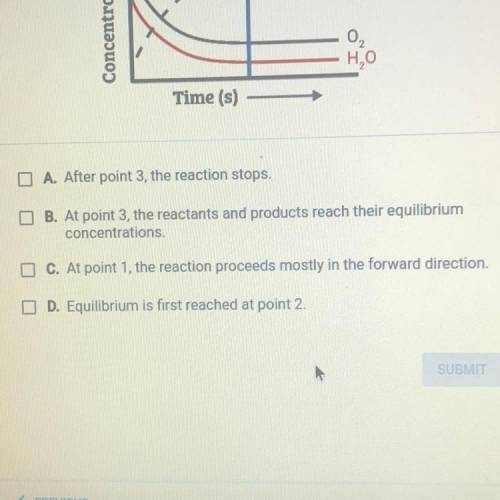
Physics, 17.11.2020 23:10 rebecca7415
The graph represents the reaction 2H20 + 02 2H2O2 as it reaches
equilibrium. Based on the graph, which two statements about this reaction
are true?


Answers: 2


Another question on Physics

Physics, 22.06.2019 16:00
Frank just graduated from eighth grade. assuming exactly four years from now he will graduate from high school how many seconds does he have until his high school graduation
Answers: 2

Physics, 22.06.2019 17:00
In the future, people will only enjoy one sport: electrodisc. in this sport, you gain points when you cause metallic discs hovering on a field to exchange charge. you are an electrodisc player playing the popular four disc variant. the disks have charges of qa = −8.0 µc, qb = −2.0 µc, qc = +5.0 µc, and qd = +12.0 µc. (1) you bring two disks together and then separate them. you measure the resulting charge of these two disks and find that it is +5.0 µc per disk. which two disks did you bring together? (a) a and b (b) a and c (c)a and d (d)b and c(e) b and d (f) c and d. (2) you bring three disks together and then separate them. you measure the resulting charge of these three disks and find that it is +3.0 µc per disk. which three disks did you bring together? a, b, and c (a) a, b, and d (c) a, c, and d (d) b, c, and d. (3) given the resulting charge of each disk measured in (b) is +3.0 µc, how many electrons would you need to add to a disk of this charge to electrically neutralize it? electrons
Answers: 3

Physics, 22.06.2019 19:30
Amass m = 74 kg slides on a frictionless track that has a drop, followed by a loop-the-loop with radius r = 18.4 m and finally a flat straight section at the same height as the center of the loop (18.4 m off the ground). since the mass would not make it around the loop if released from the height of the top of the loop (do you know why? ) it must be released above the top of the loop-the-loop height. (assume the mass never leaves the smooth track at any point on its path.) 1. what is the minimum speed the block must have at the top of the loop to make it around the loop-the-loop without leaving the track? 2. what height above the ground must the mass begin to make it around the loop-the-loop? 3. if the mass has just enough speed to make it around the loop without leaving the track, what will its speed be at the bottom of the loop? 4. if the mass has just enough speed to make it around the loop without leaving the track, what is its speed at the final flat level (18.4 m off the ground)? 5. now a spring with spring constant k = 15600 n/m is used on the final flat surface to stop the mass. how far does the spring compress?
Answers: 3

Physics, 23.06.2019 17:30
Which is the most common use for infrared waves? to determine relative distance to provide heat to carry cell phone conversations to transmit signals
Answers: 1
You know the right answer?
The graph represents the reaction 2H20 + 02 2H2O2 as it reaches
equilibrium. Based on the graph, wh...
Questions



Mathematics, 18.09.2019 12:30


History, 18.09.2019 12:30

English, 18.09.2019 12:30

Chemistry, 18.09.2019 12:30





Social Studies, 18.09.2019 12:30





Mathematics, 18.09.2019 12:30

Geography, 18.09.2019 12:30

Health, 18.09.2019 12:30



